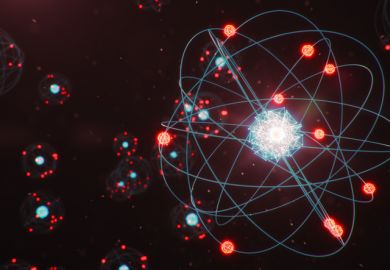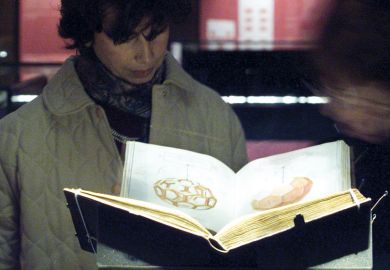John Archibald Wheeler has been a major figure at the frontiers of fundamental physics for more than 50 years. That much I knew when I began his autobiography, plus the fact that he had been the thesis adviser for Nobel laureate Richard Feynman during his time in Princeton. I knew, too, that Wheeler had a keen interest in general relativity and is the co-author of one of the standard texts on gravitation. Another of his students, Hugh Everett, was first to propose the "many worlds" interpretation of quantum mechanics, now a staple feature of modern science fiction. What I did not have, before reading this book, was an understanding of the full breadth of Wheeler's research achievements nor of his principled involvement with the development of the hydrogen bomb and his lifelong commitment to military research.
Wheeler has also come tantalisingly close to two Nobel prizes. The first opportunity involved his student Feynman, a pairing that reminds me of the relationship between the winners of this year's Nobel prize for physics - Gerard 't Hooft and Tini Veltman. In that case it was Veltman, the professor, who suggested to 't Hooft, the student, that he should work on the then-obscure problem of gauge field theory. Wheeler and Feynman worked together on the problem of quantum electrodynamics - "pair theory" as it was then known. Wheeler recalls excitedly ringing up Feynman to tell him about his idea that a positron - the anti-particle of the electron - could be viewed as an electron running backwards in time. This idea later proved to be a crucial component in Feynman's calculational tool kit and led directly to his famous "Feynman diagrams".
Wheeler's second near-miss centred on the "collective model" of nuclear structure. During the second world war Wheeler had worked with Niels Bohr on the theory of fission and chain reactions. Some years later, Wheeler worked with Bohr on the problem of deformations of nuclei from a spherical shape. Unfortunately, Bohr was notoriously reluctant to commit himself to a final version of a paper. In this case, from an initial draft prepared by Wheeler in 1949, the paper was finally published without Bohr's name in 1953. In the meantime, some of the key ideas had already appeared in print, and ironically, in 1975, Niels's son, Aage Bohr, shared the Nobel prize with Ben Mottelson and James Rainwater for their work on large deformations of nuclei. Wheeler still feels the disappointment and has learned to publish discovery of significance promptly.
The history of Wheeler's involvement in the development of nuclear weapons - first atomic bombs in the Manhattan Project, and then hydrogen bombs in Project Matterhorn - forms a key strand of the book. Wheeler is refreshingly honest in recalling some of his past mistakes. It was a surprise to learn that, despite his contact in Princeton with refugee physicists from Hitler's Germany, Wheeler initially thought that a German-dominated Europe might be good for long-term peace.
After the war, Wheeler was a staunch defender of the German physicist Werner Heisenberg, and, despite the proximity of Robert Oppenheimer in Princeton, remained a loyal friend of Edward Teller. Indeed, before Oppenheimer's security hearing, Wheeler advised Teller on how to testify. In 1949, the explosion of Joe-1, the first Soviet nuclear bomb, sent shock waves through the United States military. Wheeler records a meeting with the atom spy Klaus Fuchs, but I find it curious that there is no mention of the other key atom spy, Ted Hall, whose existence is confirmed in the recently published Mitrokhin Archive . Stalin and Beria had the luxury of two copies of the plans for the plutonium implosion bomb.
In spite of opposition from colleagues, Wheeler joined Teller in a crash programme to develop a hydrogen bomb. Far from being an impractical theorist, Wheeler is revealed as getting to grips with detailed numerical simulations of the Ulam-Teller mechanism and thermonuclear burning. His passionate belief that the best research brains in the US should be assisting in developing military weapons led to the formation of the Jason committee in 1960. Despite the unpopularity of his views in the Vietnam war period of the late 1960s and early 1970s, Wheeler remains unashamedly patriotic about what he calls his "public service" career.
Much of the remainder of the book is devoted to Wheeler's passion for exploring the predictions of Einstein's general relativity. With a succession of talented students Wheeler followed Oppenheimer's early lead in looking at the astronomical implications of gravity. He believed that "nature would avail itself of all the opportunities offered by the equations of valid theories" and that "physicists should think about where such extreme behaviour might occur, and look for it". Wheeler also had a great way with words - geons, wormholes and quantum foam are just three of many terms he has introduced to the language of modern physics. His greatest success in this direction was undoubtedly his introduction of the term black hole to describe a "gravitationally completely collapsed object". Black holes have captured the public imagination, appearing regularly in Star Trek and Red Dwarf . Wheeler summarised the remarkable simplicity of a black hole with the memorable phrase: "A black hole has no hair" - meaning that it would be hard to identify a particular individual when looking down on a roomful of bald heads!
With one of his most famous students, Jacob Bekenstein, he pondered about the increase in entropy - the increased disorder or loss of information - that occurred when he mixed a cold cup of tea with a hot one. In typical Wheeler fashion, he remarked: "The consequences of my crime, Jacob, echo down to the end of time. But if a black hole swims by, and I drop the teacups into it, I conceal from all the world the evidence of my crime. How remarkable!" Some months later Bekenstein came back with a simple formula for the entropy of a black hole, an idea that even Stephen Hawking took time to accept.
There is much more in this delightful book, despite its somewhat "Princeton-centric" view of the world. The famous story of Wheeler and Feynman's "duel by watches" is there, along with the inventor, John Tukey, of the term bit to describe the smallest unit of information. Indeed, the phrase "It from Bit" summarises the latest phase of Wheeler's journey through physics -his struggle to see "how the universe and all that it contains [it] arose from the myriad of yes/no choices of measurements [the bits]".
Wheeler's co-author, Kenneth Ford, another of his ex-students, has done a wonderful job in helping put this autobiography together. Nonetheless, to my mind it is the anecdotes that reveal Wheeler at his best - challenging generations of students to look in unusual directions. Wheeler takes an evident pleasure in their successes but also shows care and affection for his not-so-talented students. For Wheeler, having students around him is a necessity, not a chore. I had occasion recently to call Wheeler's secretary at Princeton and the name of Wojciech Zurek came up in conversation. "That's all right," she said, "he's family." Quite.
A. J. G. Hey is professor of computation, University of Southampton.
Geons, Black Holes and Quantum Foam
Author - John Archibald Wheeler with Kenneth Ford
ISBN - 0 393 04642 7
Publisher - Norton
Price - £19.95
Pages - 380



